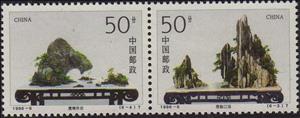Se-tenant: Se-tenant Pair (China, People's Republic 1996)
Se-tenant Pair (China, People's Republic 1996)
18 April (China, People's Republic ) within release Miniature landscapes goes into circulation Se-tenant Se-tenant Pair face value 2*50 Chinese renminbi fēn
| Se-tenant Se-tenant Pair in catalogues | |
|---|---|
| Michel: | Mi: CN 2704-2705 |
| Stanley Gibbons: | Sg: CN 4092-4093 |
Se-tenant is square format.
Also in the issue Miniature landscapes:
- Stamp - Miniature landscapes face value 20;
- Stamp - Miniature landscapes face value 20;
- Stamp - Miniature landscapes face value 50;
- Stamp - Miniature landscapes face value 50;
- Stamp - Miniature landscapes face value 100;
- Stamp - Miniature landscapes face value 100;
- Se-tenant - Se-tenant Pair face value 2*50;
- Se-tenant - Se-tenant Pair face value 2*100;
- Se-tenant - Se-tenant Pair face value 2*20;
|
Data entry completed
46%
|
|
|---|---|
| Se-tenant Se-tenant Pair in digits | |
| Country: | China, People's Republic |
| Date: | 1996-04-18 |
| Emission: | Commemorative |
| Format: | Se-tenant |
| Face Value: | 2*50 Chinese renminbi fēn |
Se-tenant Se-tenant Pair it reflects the thematic directions:
Art is a diverse range of human activities in creating visual, auditory or performing artifacts (artworks), expressing the author's imaginative or technical skill, intended to be appreciated for their beauty or emotional power. In their most general form these activities include the production of works of art, the criticism of art, the study of the history of art, and the aesthetic dissemination of art. The oldest documented forms of art are visual arts, which include creation of images or objects in fields including painting, sculpture, printmaking, photography, and other visual media. Architecture is often included as one of the visual arts; however, like the decorative arts, or advertising, it involves the creation of objects where the practical considerations of use are essential—in a way that they usually are not in a painting, for example. Music, theatre, film, dance, and other performing arts, as well as literature and other media such as interactive media, are included in a broader definition of art or the arts. Until the 17th century, art referred to any skill or mastery and was not differentiated from crafts or sciences. In modern usage after the 17th century, where aesthetic considerations are paramount, the fine arts are separated and distinguished from acquired skills in general, such as the decorative or applied arts.
A landscape is the visible features of an area of land, its landforms and how they integrate with natural or man-made features. A landscape includes the physical elements of geophysically defined landforms such as (ice-capped) mountains, hills, water bodies such as rivers, lakes, ponds and the sea, living elements of land cover including indigenous vegetation, human elements including different forms of land use, buildings and structures, and transitory elements such as lighting and weather conditions. Combining both their physical origins and the cultural overlay of human presence, often created over millennia, landscapes reflect a living synthesis of people and place that is vital to local and national identity. The character of a landscape helps define the self-image of the people who inhabit it and a sense of place that differentiates one region from other regions. It is the dynamic backdrop to people’s lives. Landscape can be as varied as farmland, a landscape park, or wilderness. The earth has a vast range of landscapes, including the icy landscapes of polar regions, mountainous landscapes, vast arid desert landscapes, islands and coastal landscapes, densely forested or wooded landscapes including past boreal forests and tropical rainforests, and agricultural landscapes of temperate and tropical regions.
Flora is the plant life occurring in a particular region or time, generally the naturally occurring or indigenous—native plant life. The corresponding term for animal life is fauna. Flora, fauna and other forms of life such as fungi are collectively referred to as biota. Sometimes bacteria and fungi are also referred to as flora, as in the terms gut flora or skin flora.



